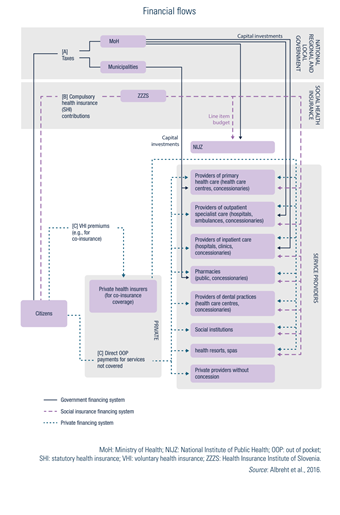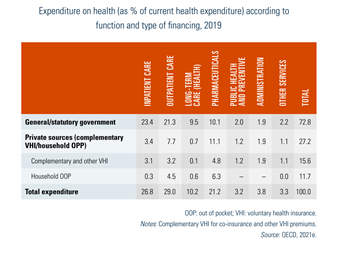-
15 September 2023 | Policy Analysis
Adoption of a new Long-Term Care Act (2023) -
01 May 2023 | Policy Analysis
New Health System Reform Strategy for Slovenia
3.2. Sources of revenue and financial flows
Revenue flows to the health care system through public and private sources (see section 3.1). The main sources of public funding are SHI contributions and general taxation, while VHI schemes – complementary and supplementary – and household OOP spending drive private financing (see Fig3.5).
Fig3.5
In 2019, 72.8% of CHE came from government (3.4%) and SHI (69.4%) (Eurostat, 2021d). Funds raised through the latter represent the largest share of the total revenue for health from all sources. In 2018, 92% of all publicly sourced health expenditure came from SHI or the pension insurance fund (UMAR, 2020c). For more information on SHI, see section 3.3.
General national and municipal level taxation covers costs for capital investments and national public health programmes (i.e. cancer screening) and ensures financial resources for socially vulnerable groups (see section 4.1). In terms of municipal health budgets, besides raising taxes, municipalities receive additional resources from the central government, which fund capital investment for public health centres and public pharmacies within their territories (section 3.3.2). During the COVID-19 pandemic, the central government budget was a source of financing for pandemic-specific measures (e.g. protection equipment for health care staff, financing sick leave connected to COVID-19 quarantine).
In 2018, national sources show that 73% of the Slovene population (or 95% of those liable for co-insurance) has complementary VHI (UMAR, 2020b) (see section 3.5). Complementary VHI contributions represented €525.8 million, or 14% of total health spending (€3.789 billion) (ZZZS, 2019; Zver, 2021). OOP payments, primarily for medicines and dental care and some outpatient care (section 3.4), account for €454.9 million or 12.0 % of total health expenditures (€3.789 billion) (ZZZS, 2020; Zver, 2021).
According to disaggregated data on health expenditure by function and financing scheme (Table3.2), the main areas of health expenditure in 2019 were outpatient and inpatient care, with 55.8% of total health expenditure, almost entirely from SHI and VHI premiums (51% of CHE).
Table3.2
Since 2010, financial incentives have facilitated a shift from inpatient to outpatient care (see sections 3.7.1 and 4.1), leading to higher spending in the latter. In 2019, inpatient care received 26.8% of CHE, while outpatient care amounted to 29% of CHE (Table3.2). Medical goods including pharmaceuticals receive 21.2% of CHE, financed mainly through OOP payments and VHI (OECD, 2021e). At 10.2% of health expenditure, Slovenia spends considerably less than the EU27 average (16.3%) on LTC. Looking forward, though LTC legislation is due to be adopted by the end of 2021, it is unclear how the legislation will impact on the financing or availability of services (see Chapter 6).
The COVID-19 crisis prompted additional funding injections in 2020 and 2021 to support the health sector. Because the crisis was officially declared a pandemic, according to law, the government assumed responsibility for the procurement of the necessary equipment and medicines for all public health care settings. The government health budget also fully covers testing and subsequent COVID-19-related health treatment.
On 21 July 2023 the National Assembly adopted the Long-term Care Act, replacing the Long-term Care Act (2021) (see “Long-Term Care Act adopted by Parliament in December 2021” https://eurohealthobservatory.who.int/monitors/health-systems-monitor/updates/hspm/slovenia-2022/long-term-care-act-adopted-by-parliament-in-december-2021).
In November 2022, the application of some of the provisions of the 2021 Act was postponed via a referendum, leading to a new Ministry of Solidarity-Based Future was established with, among others, responsibilities for LTC. The Ministry submitted the new 2023 Act in June 2023, keeping most of the main solutions foreseen in the previous Act, with a notable exception being the financing arrangements for LTC.
The provisions described refer to the 2023 Act:
Access to LTC is ensured via “compulsory insurance for long-term care”. The 2023 Long-term Care Act introduces a new nationally standardized instrument to assess individual needs for (and rights to) for LTC. The assessment instrument was piloted in several settings prior to the adoption of the Act. These assessments will be performed at so-called “entry points” in local Centres for Social Work and allocated a person to 1 of 5 LTC categories. The resulting category designated to an individual more specifically determines the level of need and the extent to which each of these services will be available to them.
The types of LTC support determined by the Act are:
- continuous LTC in institutions
- daily LTC in institutions
- LTC at home
- care provided by a family member, and
- right to monetary transfers.
Funds for LTC insurance will be collected from employers and employees similarly to health insurance contributions, whereby each (that is, employer and employee) will contribute 1% of the worker’s salary. Special provisions apply to particular employment arrangements, for example, self-employed persons. Additionally, €190 million (approximately 0.4% of Slovenia’s GDP) will be added annually from the national budget.
According to government estimates, the full set of services and the full costs of the new system will be apparent in 2026. Total LTC expenditure is estimated to increase from 1.45% of GDP in 2020 to 1.72% of GDP in 2026. Nominally, the private contribution to expenditure is expected to increase (from €164 million in 2020 to €244 million in 2026). However, given higher total spending on LTC, private expenditure as a share of total LTC expenditure is expected to decrease from 24.1% to 18.7%.
A major challenge to the implementation of the Act in full is the timely and effective upgrade or establishment of LTC services foreseen in the Act, especially strengthening capacity for home care.
Authors
References
Official Gazette of the Republic of Slovenia, no. 84/23 (available at https://www.uradni-list.si/glasilo-uradni-list-rs/vsebina/2023-01-2570?sop=2023-01-2570)
Official Gazette of the Republic of Slovenia, no. 196/21 and following (available at http://www.pisrs.si/Pis.web/pregledPredpisa?id=ZAKO7621)
Social Protection Institute of the Republic of Slovenia, Priprava podlag za izvedbo pilotnih projektov, ki bodo podpirali prehod v izvajanje sistemskega zakona o dolgotrajni oskrbi [Preparation of the foundations for the implementation of pilot projects that will support the transition to the implementation of the Long-Term Care Act], Ljubljana: Social Protection Institute of the Republic of Slovenia, 2017.
Ministry of Health, Izvedba pilotnih projektov, ki bodo podpirali prehod v izvajanje sistemskega zakona o dolgotrajni oskrbi [Implementation of pilot projects that will support the transition to the implementation of the Long-Term Care Act], Web resource available at https://www.gov.si/zbirke/projekti-in-programi/izvedba-pilotnih-projektov-ki-bodo-podpirali-prehod-v-izvajanje-sistemskega-zakona-o-dolgotrajni-oskrbi
Ministry of Health, Preoblikovanje obstoječih mrež ter vstop novih izvajalcev za nudenje skupnostnih storitev in programov za starejše [Transformation of existing networks and entry of new providers to offer community services and programs for the elderly], web resource available at https://www.gov.si/zbirke/projekti-in-programi/prilagoditev-in-preoblikovanje-obstojecih-mrez-institucionalnega-varstva-ter-vstop-novih-izvajalcev-za-nudenje-skupnostnih-storitev-in-programov-za-starejse
Proposal of Government to Parliament to adopt the Long-term Care Act, available at https://imss.dz-rs.si/IMiS/ImisAdmin.nsf/ImisnetAgent?OpenAgent&2&DZ-MSS-01/f6a83ef74c5e82949c453cfbc2edb300a7db29797d43f941139bb09356bc566b
The Prime Minister(PM)’s 22-member Advisory Board for the health system reform process has been meeting weekly to advance reform efforts. (See the policy analysis of 3 February 2023: “Whole-system Health Reform preparation formally launched in Slovenia”.) It has several subgroups, including medical faculties, primary care, financing of healthcare, health system governance, emergency medical services, and absenteeism. By the end of April 2023, it had prepared the following recommendations:
- Medical education – increase future admissions by at least 20%; enhance training capacity in regional hospitals and establish a possible third medical faculty.
- Absenteeism – address the current impasse, in which many patients experience a status between long-term sickness absence and disability.
- Primary care – clarify the status of patients not able to register with a GP of choice; incentivize junior doctors to choose primary care; revise completely the existing capitation formula, which has been applied since 2017 for workforce calculation, despite not being designed for this.
- Pharmacies – strengthen the role of pharmacies in local communities, potentially adding preventative services.
Additionally, three legal acts are under public discussion:
- Separate law for the Health Insurance Institute of Slovenia (HIIS): A separate law on the HIIS would reform the status, set-up and management of HIIS. HIIS would be registered as an insurance company, not a public institution. Rather than three management bodies – the CEO, the Management Board and the 45-member Assembly (25 insured representatives, 20 employers representatives) – the CEO and Board of three members – General CEO, vice-chair for compulsory health insurance and vice-chair for long-term insurance – would merge. The Assembly would also decrease to 11 members, representing the insured (6), employers (2), government (2), and employees of the HIIS (1).
- Law on digitalisation of the health information system: A special independent agency would be set up to oversee and implement the entire e-health and national reporting infrastructure. This would be managed by a special company and financed from a fixed percentage of the total health insurance budget. This is initially set at 3% and increased to 4.5% after three years; altogether, almost 10 times more money would be dedicated to e-health and digitalisation than currently, though there are some doubts to the feasibility of the funding source. Further, all national registries and data collection would transfer to five basic registries. It is unclear how these would be managed content-wise or by what methodology since the new agency would primarily oversee IT infrastructure. Nor is it clear how the complex international reporting obligations to Eurostat (legally binding), WHO and OECD would be fulfilled under this new system.
- Abolishment of complementary health insurance (CoHI) and corresponding amendments to the Health Care and Health Insurance Act (HCHIA): Triggered by a large increase in premiums by one CoHI company of almost 30% from 1 May 2023, the PM announced the future abolishment of CoHI. The proposal includes a freeze on premiums until September 2023 by which time the necessary amendments to the HCHIA should be adopted. This means that the present system of expansive CoHI would cease to exist by January 2024 at the latest. While this change may be an opportunity to (re)define the basic benefits basket and establish co-insurance for services not covered, it is unclear when and how this will occur.
References
- Law on the Health Insurance Institute of Slovenia, Draft law: https://e-uprava.gov.si/si/drzava-in-druzba/e-demokracija/predlogi-predpisov/predlog-predpisa.html?id=15438
- Law on the Health Information System: https://e-uprava.gov.si/si/drzava-in-druzba/e-demokracija/predlogi-predpisov/predlog-predpisa.html?id=15432


